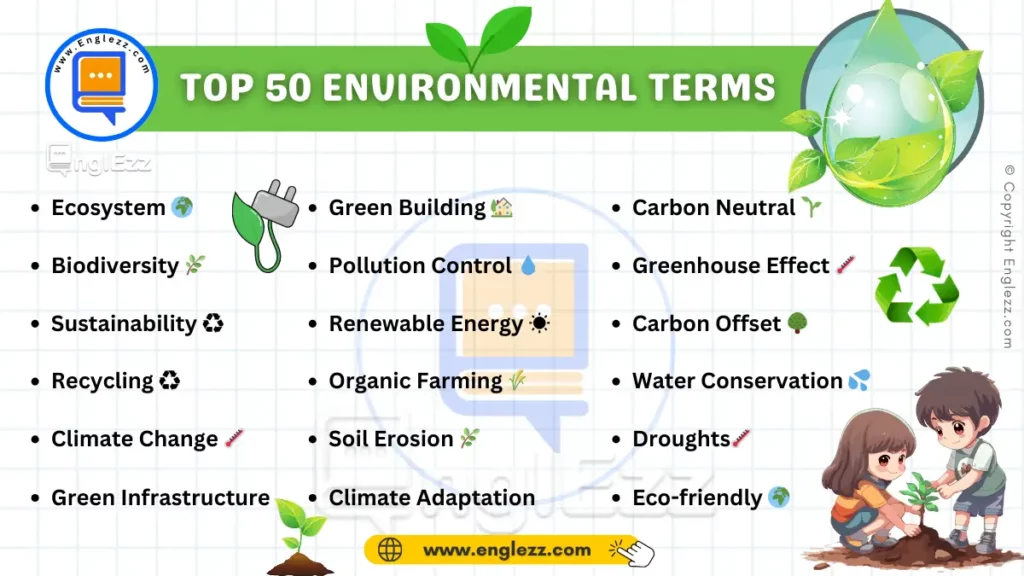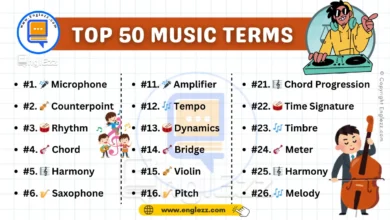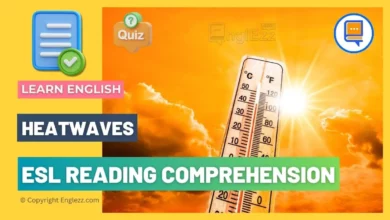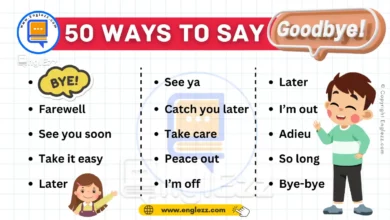Understanding environmental English terms is crucial for anyone involved in or interested in environmental science, policy, or activism. The vocabulary used in discussions about the environment can be complex and varied, reflecting the diverse issues and solutions related to sustainability, conservation, and climate change. In this blog post, we will explore 50 essential environmental English terms.
Table of Contents
- 50 Essential Environmental English Terms You Need to Know
- #1. Ecosystem 🌍
- #2. Biodiversity 🌿
- #3. Sustainability ♻️
- #4. Greenhouse Gas 🌡️
- #5. Conservation 🌲
- #6. Carbon Footprint 🏞️
- #7. Renewable Energy 🌞
- #8. Pollution 💨
- #9. Climate Change 🌍
- #10. Ecosystem Services 🌿
- #11. Sustainable Development 🌱
- #12. Deforestation 🌳
- #13. Waste Management ♻️
- #14. Habitat 🌏
- #15. Green Energy 🌿
- #16. Natural Resources 🌲
- #17. Carbon Sequestration 🌳
- #18. Environmental Impact 🌍
- #19. Greenwashing ♻️
- #20. Environmental Policy 🌐
- #21. Urbanization 🏙️
- #22. Recycling ♻️
- #23. Conservationist 🌿
- #24. Environmentalism 🌏
- #25. Organic Farming 🌾
- #26. Carbon Neutral 🌱
- #27. Green Building 🏡
- #28. Eco-friendly 🌍
- #29. Environmental Stewardship 🌳
- #30. Greenhouse Effect 🌡️
- #31. Environmental Impact Assessment 📝
- #32. Pollution Control 💧
- #33. Environmental Justice ⚖️
- #34. Ecological Footprint 🌏
- #35. Sustainable Agriculture 🚜
- #36. Eco-system Balance ⚖️
- #37. Resource Efficiency 💡
- #38. Zero Waste ♻️
- #39. Ecosystem Restoration 🌱
- #40. Environmental Education 📚
- #41. Water Conservation 💦
- #42. Soil Erosion 🌿
- #43. Climate Adaptation 🌡️
- #44. Green Infrastructure 🌳
- #45. Carbon Offset 🌳
- #46. Energy Efficiency 💡
- #47. Urban Green Spaces 🌳
- #48. Natural Capital 🌍
- #49. Climate Resilience 🌱
- #50. Environmental Footprint 🌍
- Environmental English Terms Table
- Conclusion
50 Essential Environmental English Terms You Need to Know
Each term will be presented with a clear definition, phonetic transcription, and practical examples to illustrate its use. This comprehensive guide aims to enhance your environmental vocabulary and help you communicate more effectively about ecological matters.
Whether you’re a student, professional, or just an enthusiast, this list will provide valuable insights into the language that shapes our understanding and action towards environmental issues.
Stay tuned to expand your knowledge and become more adept at discussing environmental topics.
#1. Ecosystem 🌍
Definition: A biological community of interacting organisms and their physical environment.
Phonetic Transcription: /ˈiːkoʊˌsɪstəm/
Examples:
- The Amazon rainforest is a diverse ecosystem with countless species.
- Coastal ecosystems are vital for supporting marine life and protecting shorelines.
#2. Biodiversity 🌿
Definition: The variety of life in the world or in a particular habitat or ecosystem.
Phonetic Transcription: /ˌbaɪoʊdaɪˈvɜːrsɪti/
Examples:
- Protecting biodiversity is essential for maintaining healthy ecosystems.
- The biodiversity in coral reefs is crucial for marine health.
#3. Sustainability ♻️
Definition: The ability to maintain ecological balance by avoiding depletion of natural resources.
Phonetic Transcription: /səˌsteɪnəˈbɪləti/
Examples:
- Sustainable farming practices help preserve soil and water resources.
- Many companies are adopting sustainability measures to reduce their environmental footprint.
#4. Greenhouse Gas 🌡️
Definition: Gases in Earth’s atmosphere that trap heat, contributing to global warming.
Phonetic Transcription: /ˈɡriːnˌhaʊs ɡæs/
Examples:
- Carbon dioxide and methane are major greenhouse gases.
- Reducing greenhouse gas emissions is critical to combating climate change.
#5. Conservation 🌲
Definition: The protection and preservation of natural resources and environments.
Phonetic Transcription: /ˌkɒnsərˈveɪʃən/
Examples:
- Wildlife conservation efforts focus on protecting endangered species.
- Conservation practices include recycling and reducing waste.
#6. Carbon Footprint 🏞️
Definition: The total amount of greenhouse gases emitted by an individual, organization, or product.
Phonetic Transcription: /ˈkɑːrbən ˈfʊtprɪnt/
Examples:
- Reducing your carbon footprint can involve using energy-efficient appliances.
- Companies are measuring their carbon footprint to develop strategies for reduction.
#7. Renewable Energy 🌞
Definition: Energy from sources that are naturally replenished, such as sunlight, wind, or geothermal heat.
Phonetic Transcription: /rɪˈnjuːəbl ˈɛnərdʒi/
Examples:
- Solar panels are a popular method of generating renewable energy.
- Wind turbines convert wind energy into electricity.
#8. Pollution 💨
Definition: The presence or introduction of harmful substances into the environment.
Phonetic Transcription: /pəˈluːʃən/
Examples:
- Air pollution from factories can have detrimental effects on health.
- Plastic pollution in oceans threatens marine life.
#9. Climate Change 🌍
Definition: Long-term alteration of temperature and typical weather patterns in a place.
Phonetic Transcription: /ˈklaɪmət ʧeɪndʒ/
Examples:
- Climate change is leading to more frequent and severe weather events.
- Reducing carbon emissions is essential for mitigating climate change.
#10. Ecosystem Services 🌿
Definition: The benefits that humans receive from ecosystems, such as clean water and air.
Phonetic Transcription: /ˈiːkoʊˌsɪstəm ˈsɜːrvɪsɪz/
Examples:
- Forests provide ecosystem services like air purification and flood control.
- Wetlands act as natural water filters and support wildlife.
#11. Sustainable Development 🌱
Definition: Economic development that is conducted without depletion of natural resources.
Phonetic Transcription: /səˈsteɪnəbl dɪˈvɛləpmənt/
Examples:
- Sustainable development aims to balance economic growth with environmental protection.
- Green building practices are a form of sustainable development.
#12. Deforestation 🌳
Definition: The process of clearing forests for non-forest uses.
Phonetic Transcription: /ˌdiːˌfɔːrɪˈsteɪʃən/
Examples:
- Deforestation contributes to loss of biodiversity and climate change.
- Efforts to combat deforestation include reforestation and sustainable logging.
#13. Waste Management ♻️
Definition: The collection, transport, processing, recycling, or disposal of waste materials.
Phonetic Transcription: /weɪst ˈmænɪdʒmənt/
Examples:
- Effective waste management practices can reduce landfill use and pollution.
- Recycling programs are a key component of waste management.
#14. Habitat 🌏
Definition: The natural home or environment of an animal, plant, or other organism.
Phonetic Transcription: /ˈhæbɪtæt/
Examples:
- Conservationists work to preserve natural habitats for endangered species.
- Urban development can lead to the destruction of animal habitats.
#15. Green Energy 🌿
Definition: Energy derived from natural sources that are environmentally friendly.
Phonetic Transcription: /ɡriːn ˈɛnərdʒi/
Examples:
- Green energy solutions include wind, solar, and hydro power.
- Switching to green energy can help reduce your carbon footprint.
#16. Natural Resources 🌲
Definition: Materials or substances occurring in nature which can be exploited for economic gain.
Phonetic Transcription: /ˈnætʃərəl rɪˈsɔːrsɪz/
Examples:
- Water, minerals, and forests are examples of natural resources.
- Sustainable management of natural resources is crucial for long-term availability.
#17. Carbon Sequestration 🌳
Definition: The process of capturing and storing atmospheric carbon dioxide.
Phonetic Transcription: /ˈkɑːrbən ˌsiːkwɛsˈtreɪʃən/
Examples:
- Forests and oceans play a significant role in carbon sequestration.
- Technologies for carbon sequestration are being developed to mitigate climate change.
#18. Environmental Impact 🌍
Definition: The effect of human activities on the environment.
Phonetic Transcription: /ɪnˌvaɪrənˈmɛntl ˈɪmpækt/
Examples:
- Industrial activities can have a significant environmental impact.
- Conducting an environmental impact assessment helps identify and mitigate adverse effects.
#19. Greenwashing ♻️
Definition: The practice of making misleading claims about the environmental benefits of a product or service.
Phonetic Transcription: /ˈɡriːnˌwɑːʃɪŋ/
Examples:
- Greenwashing can mislead consumers about the true environmental impact of products.
- Companies may use greenwashing to appear more eco-friendly without making substantial changes.
#20. Environmental Policy 🌐
Definition: Regulations and guidelines set by governments or organizations to protect the environment.
Phonetic Transcription: /ɪnˌvaɪrənˈmɛntl ˈpɒlɪsi/
Examples:
- Environmental policies can include regulations on emissions and waste management.
- Effective environmental policy helps ensure sustainable use of resources.

#21. Urbanization 🏙️
Definition: The process by which cities grow and become more densely populated.
Phonetic Transcription: /ˌɜːrbənɪˈzeɪʃən/
Examples:
- Rapid urbanization can lead to increased pollution and habitat loss.
- Sustainable urbanization practices focus on green building and efficient transportation.
#22. Recycling ♻️
Definition: The process of converting waste into reusable material.
Phonetic Transcription: /rɪˈsaɪklɪŋ/
Examples:
- Recycling paper and plastic helps reduce landfill waste.
- Many communities have recycling programs to encourage waste separation.
#23. Conservationist 🌿
Definition: A person who advocates for the protection and preservation of natural resources.
Phonetic Transcription: /ˌkɒnsəˈveɪʃənɪst/
Examples:
- Conservationists work to protect endangered species and their habitats.
- Many conservationists engage in community education about environmental issues.
#24. Environmentalism 🌏
Definition: A broad philosophy and social movement focused on the conservation and improvement of the environment.
Phonetic Transcription: /ɪ
nˌvaɪrənˈmɛntəlɪzəm/
Examples:
- Environmentalism often involves advocating for policies and practices that reduce harm to the environment.
- The rise of environmentalism has led to increased awareness of climate change.
#25. Organic Farming 🌾
Definition: A method of farming that avoids synthetic pesticides and fertilizers, focusing on natural processes.
Phonetic Transcription: /ɔːrˈɡænɪk ˈfɑːrmɪŋ/
Examples:
- Organic farming practices aim to improve soil health and biodiversity.
- Many consumers choose organic produce to avoid chemicals and support sustainable agriculture.
#26. Carbon Neutral 🌱
Definition: Achieving a balance between the carbon emitted and the carbon removed from the atmosphere.
Phonetic Transcription: /ˈkɑːrbən ˈnjuːtrəl/
Examples:
- Companies can become carbon neutral by reducing emissions and offsetting the remainder.
- Individuals can calculate their carbon footprint and invest in carbon offsets to become carbon neutral.
#27. Green Building 🏡
Definition: Designing and constructing buildings that are environmentally responsible and resource-efficient.
Phonetic Transcription: /ɡriːn ˈbɪldɪŋ/
Examples:
- Green building techniques include using sustainable materials and energy-efficient systems.
- Many new developments are incorporating green building practices to reduce their environmental impact.
#28. Eco-friendly 🌍
Definition: Products or practices that have a minimal impact on the environment.
Phonetic Transcription: /ˈiːkoʊˈfrɛndli/
Examples:
- Eco-friendly products are made from sustainable materials and are recyclable.
- Using eco-friendly cleaning products helps reduce chemical pollution.
#29. Environmental Stewardship 🌳
Definition: The responsible management of natural resources to protect and sustain the environment.
Phonetic Transcription: /ɪnˌvaɪrənˈmɛntəl ˈstjuːərdʃɪp/
Examples:
- Environmental stewardship involves practices like conserving water and reducing waste.
- Companies and individuals can both engage in environmental stewardship to support sustainability.
#30. Greenhouse Effect 🌡️
Definition: The warming of Earth’s surface due to trapped heat by greenhouse gases.
Phonetic Transcription: /ˈɡriːnˌhaʊs ɪˈfɛkt/
Examples:
- The greenhouse effect is a natural process, but human activities have intensified it.
- Reducing greenhouse gas emissions is key to mitigating the greenhouse effect.
#31. Environmental Impact Assessment 📝
Definition: A process to evaluate the potential environmental effects of a proposed project or action.
Phonetic Transcription: /ɪnˌvaɪrənˈmɛntəl ˈɪmpækt əˈsɛsmənt/
Examples:
- An environmental impact assessment helps identify potential negative effects before a project begins.
- Regulations often require an environmental impact assessment for large construction projects.
#32. Pollution Control 💧
Definition: Measures and technologies used to reduce or eliminate pollutants released into the environment.
Phonetic Transcription: /pəˈluːʃən kənˈtroʊl/
Examples:
- Pollution control devices in factories help reduce air emissions.
- Water treatment facilities use pollution control methods to ensure clean water.
#33. Environmental Justice ⚖️
Definition: The fair treatment and meaningful involvement of all people in environmental policies and practices.
Phonetic Transcription: /ɪnˌvaɪrənˈmɛntəl ˈdʒʌstɪs/
Examples:
- Environmental justice aims to address disparities in environmental impacts among different communities.
- Advocates work to ensure that marginalized groups have a voice in environmental decision-making.
#34. Ecological Footprint 🌏
Definition: The measure of human demand on the Earth’s ecosystems and natural resources.
Phonetic Transcription: /ˌiːkəˈlɒdʒɪkəl ˈfʊtprɪnt/
Examples:
- Reducing your ecological footprint involves adopting sustainable practices in daily life.
- Countries with high ecological footprints consume more resources than their ecosystems can regenerate.
#35. Sustainable Agriculture 🚜
Definition: Farming methods that maintain the health of the soil, ecosystem, and people over the long term.
Phonetic Transcription: /səˈsteɪnəbl ˌæɡrɪˈkʌltʃər/
Examples:
- Sustainable agriculture practices include crop rotation and organic farming.
- This approach reduces environmental impact and supports long-term food security.
#36. Eco-system Balance ⚖️
Definition: The equilibrium between living organisms and their environment that supports life processes.
Phonetic Transcription: /ˈiːkoʊˌsɪstəm ˈbæləns/
Examples:
- Maintaining ecosystem balance is crucial for the health of both wildlife and human populations.
- Disruptions like pollution or deforestation can threaten ecosystem balance.
#37. Resource Efficiency 💡
Definition: Using resources in a way that maximizes their utility while minimizing waste and environmental impact.
Phonetic Transcription: /rɪˈsɔːrs ɪˈfɪʃənsi/
Examples:
- Resource efficiency can be improved through practices like reducing energy consumption and recycling.
- Businesses often implement resource efficiency measures to lower costs and environmental impact.
#38. Zero Waste ♻️
Definition: A waste management philosophy aimed at reducing waste to landfills and incineration to as close to zero as possible.
Phonetic Transcription: /ˈziːroʊ weɪst/
Examples:
- Zero waste practices include composting and reusing materials.
- Many cities are adopting zero waste policies to improve environmental sustainability.
#39. Ecosystem Restoration 🌱
Definition: The process of aiding the recovery of damaged or degraded ecosystems.
Phonetic Transcription: /ˌiːkoʊˌsɪstəm rɛstəˈreɪʃən/
Examples:
- Ecosystem restoration projects often involve replanting native vegetation.
- Restoring wetlands can improve water quality and provide habitat for wildlife.
#40. Environmental Education 📚
Definition: Teaching and learning about the environment and how to protect it.
Phonetic Transcription: /ɪnˌvaɪrənˈmɛntəl ˌɛdjuˈkeɪʃən/
Examples:
- Environmental education programs aim to increase awareness and encourage sustainable behaviors.
- Schools often incorporate environmental education into their curricula to promote ecological literacy.
#41. Water Conservation 💦
Definition: The practice of using water efficiently to reduce unnecessary water usage.
Phonetic Transcription: /ˈwɔːtər ˌkɒnsəˈveɪʃən/
Examples:
- Water conservation techniques include fixing leaks and using water-efficient fixtures.
- Conserving water helps ensure a sustainable supply for future generations.
#42. Soil Erosion 🌿
Definition: The removal of the top layer of soil by wind, water, or human activity.
Phonetic Transcription: /sɔɪl ɪˈroʊʒən/
Examples:
- Soil erosion can lead to loss of fertile land and increased sediment in waterways.
- Practices like planting cover crops can help prevent soil erosion.
#43. Climate Adaptation 🌡️
Definition: Adjusting practices, processes, and structures to minimize the impact of climate change.
Phonetic Transcription: /ˈklaɪmət əˌdæptˈeɪʃən/
Examples:
- Climate adaptation strategies might include building sea walls to protect against rising sea levels.
- Farmers may adapt to climate change by altering crop varieties and irrigation methods.
#44. Green Infrastructure 🌳
Definition: Natural or semi-natural systems that provide environmental and economic benefits.
Phonetic Transcription: /ɡriːn ˈɪnfrəˌstrʌkʧər/
Examples:
- Green infrastructure includes urban parks and green roofs that help manage stormwater.
- Implementing green infrastructure can improve city resilience to climate change.
#45. Carbon Offset 🌳
Definition: A reduction in emissions of carbon dioxide or other greenhouse gases to compensate for emissions elsewhere.
Phonetic Transcription: /ˈkɑːrbən ˈɒfˌsɛt/
Examples:
- Purchasing carbon offsets can help balance out personal or corporate carbon emissions.
- Projects that plant trees are often funded as carbon offset initiatives.
#46. Energy Efficiency 💡
Definition: Using less energy to perform the same task or produce the same result.
Phonetic Transcription: /ˈɛnərdʒi ɪˈfɪʃənsi/
Examples:
- Energy-efficient appliances consume less power and reduce utility bills.
- Upgrading insulation in buildings can improve energy efficiency.
#47. Urban Green Spaces 🌳
Definition: Areas of vegetation within urban environments that provide recreational and ecological benefits.
Phonetic Transcription: /ˈɜːrbən ɡriːn speɪsɪz/
Examples:
- Urban green spaces like parks and community gardens enhance city living conditions.
- Green spaces help reduce urban heat islands and provide habitats for wildlife.
#48. Natural Capital 🌍
Definition: The world’s stocks of natural assets including geology, soil, air, water, and all living things.
Phonetic Transcription: /ˈnætʃərəl ˈkæpɪtl/
Examples:
- Protecting natural capital involves conserving ecosystems and biodiversity.
- Economic value can be attributed to natural capital through ecosystem services.
#49. Climate Resilience 🌱
Definition: The capacity of a system to anticipate, prepare for, respond to, and recover from climate impacts.
Phonetic Transcription: /ˈklaɪmət rɪˈzɪljəns/
Examples:
- Building climate resilience includes developing infrastructure that can withstand extreme weather events.
- Communities can enhance climate resilience through disaster preparedness and sustainable practices.
#50. Environmental Footprint 🌍
Definition: The measure of the impact of human activities on the environment, often assessed in terms of resource use and waste production.
Phonetic Transcription: /ɪnˌvaɪrənˈmɛntəl ˈfʊtprɪnt/
Examples:
- Reducing your environmental footprint can involve adopting a more sustainable lifestyle.
- Companies often assess their environmental footprint to implement greener practices.
Environmental English Terms Table
| Ecosystem 🌍 | Green Building 🏡 | Carbon Neutral 🌱 |
| Biodiversity 🌿 | Pollution Control 💧 | Greenhouse Effect 🌡️ |
| Sustainability ♻️ | Renewable Energy ☀️ | Carbon Offset 🌳 |
| Recycling ♻️ | Organic Farming 🌾 | Water Conservation 💦 |
| Climate Change 🌡️ | Soil Erosion 🌿 | Climate Adaptation 🌡️ |
| Green Infrastructure 🌳 | Environmental Justice ⚖️ | Eco-friendly 🌍 |
| Environmentalism 🌱 | Resource Efficiency 💡 | Urban Green Spaces 🌳 |
| Ecosystem Restoration 🌱 | Environmental Education 📚 | Energy Efficiency 💡 |
| Environmental Footprint 🌍 | Natural Capital 🌍 | Zero Waste ♻️ |
Conclusion
As we’ve explored these 50 environmental English terms, it’s clear that understanding and utilizing this vocabulary is essential for addressing environmental challenges and promoting sustainability. From concepts like “ecosystem” and “biodiversity” to practices such as “recycling” and “carbon offset,” each term plays a crucial role in our collective efforts to protect and improve our environment.
By familiarizing yourself with these terms, you enhance your ability to engage in meaningful discussions, advocate for effective policies, and contribute to positive environmental change. Whether you’re a professional, student, or simply an interested individual, expanding your environmental vocabulary equips you with the knowledge to make informed decisions and take action.
Let’s continue to build a more sustainable future by staying informed and proactive in our environmental efforts









Dive into our comprehensive guide on 50 essential environmental English terms! 🌿 Whether you’re passionate about sustainability or just looking to expand your vocabulary, this post has you covered. Discover key terms, their definitions, and practical examples to boost your environmental literacy.
Follow and like @EnglEzz for more insights! 🌍💚 Read more here
https://www.englezz.com/essential-environmental-english-terms/
.
#englezz #vocabulary #linguistics #sustainability #greenbuilding #recycling #carbonneutral #ecofriendly #environmentaljustice